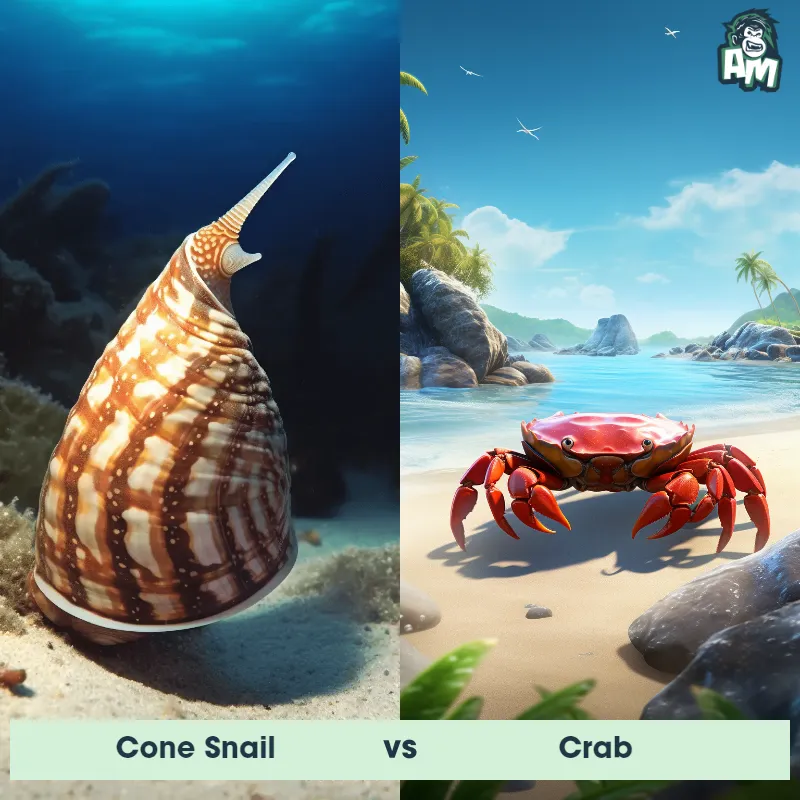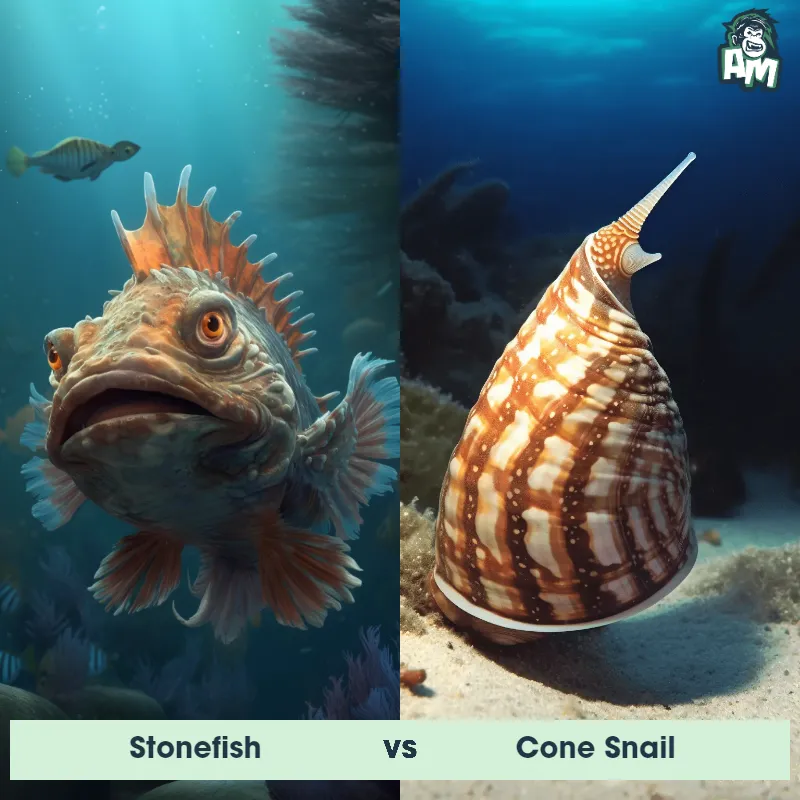The Cone Snail
The Cone Snail, also known as Conus, is a marine gastropod mollusk that can be found in tropical and subtropical waters around the world. These snails have a unique and beautiful cone-shaped shell, hence their common name. They vary in size, with some species reaching up to 9 inches in length. Cone Snails are known for their venomous harpoons, called radula, which they use to immobilize and capture their prey, mainly fish and other snails. This venom is highly toxic, and although it can be deadly to humans, it is also being studied for potential medical uses.

| Cone Snail | |
|---|---|
| Size | Ranges from a few centimeters to over 20 cm (8 in) (metric: 2.5 cm to over 50 cm) |
| Weight | Varies by species (metric: varies by species) |
| Speed | Speed: 0.5 mph (0.8 km/hr) |
| Key Strength | Venomous sting |
| Biggest Weakness | None |
| Scientific Name | Conus |
| Family | Conidae |
| Habitat | Marine |
| Geography | Warm waters around the world |
| Diet | Carnivorous, feeds on fish, worms, and other snails |
| Lifespan | Up to 4 years - Up to 20 years |

The Cone Snail
The Cone Snail, also known as Conus, is a marine gastropod mollusk that can be found in tropical and subtropical waters around the world. These snails have a unique and beautiful cone-shaped shell, hence their common name. They vary in size, with some species reaching up to 9 inches in length. Cone Snails are known for their venomous harpoons, called radula, which they use to immobilize and capture their prey, mainly fish and other snails. This venom is highly toxic, and although it can be deadly to humans, it is also being studied for potential medical uses.
Fun Fact: One fun fact about Cone Snails is that they have an incredibly diverse range of venom, with each species producing a different cocktail of toxins to paralyze and kill their prey.
| Cone Snail | |
|---|---|
| Size | Ranges from a few centimeters to over 20 cm (8 in) (metric: 2.5 cm to over 50 cm) |
| Weight | Varies by species (metric: varies by species) |
| Speed | Speed: 0.5 mph (0.8 km/hr) |
| Key Strength | Venomous sting |
| Biggest Weakness | None |
| Scientific Name | Conus |
| Family | Conidae |
| Habitat | Marine |
| Geography | Warm waters around the world |
| Diet | Carnivorous, feeds on fish, worms, and other snails |
| Lifespan | Up to 4 years - Up to 20 years |
Cone Snail Matchups
We use AI to simulate matchups between the Cone Snail and other animals. Our simulation considers size, strength, and natural predatory behaviors to determine the most likely outcome.

Can't find the Matchup you want?
Create Your Own MatchupCone Snail: Diet, Predators, Aggression, and Defensive Behaviors
What do Cone Snails eat?
Cone Snails are carnivorous predators that feed primarily on marine worms, small fish, and other snails. They use their venomous harpoon-like teeth to inject a potent neurotoxin into their prey, paralyzing them almost instantly.
Do Cone Snails have any predators?
While adult Cone Snails do not have many natural predators due to their venomous nature, some species of crabs and other specialized predators are known to prey on Cone Snail eggs and young snails.
Are Cone Snails aggressive?
Cone Snails are not typically aggressive towards humans or other animals unless they feel threatened. They are known to be relatively slow-moving creatures that prefer to hunt and feed on unsuspecting prey rather than actively seek out confrontation.
Do Cone Snails fight other animals or each other?
Cone Snails do not exhibit territorial behavior or actively engage in fights with other animals or their own kind. They are solitary creatures that primarily focus on hunting for food rather than engaging in physical confrontations.
How do Cone Snails defend themselves?
Cone Snails primarily rely on their potent venom as a means of defense against potential threats. When feeling threatened or disturbed, they can extend their proboscis and harpoon-like teeth, delivering a paralyzing toxin to deter predators.
What is the biggest weakness of Cone Snails in a fight?
Despite their powerful venom and defensive mechanisms, Cone Snails have a limited range of attack and rely heavily on their hunting techniques to catch prey. In a fight, their slow movement and limited agility make them vulnerable to faster and more agile predators. Additionally, their venomous defense mechanism may not be effective against all potential threats, leaving them susceptible to certain predators that are immune to their toxins.
Fun Fact: Another interesting fact about Cone Snails is that they are considered one of the slowest-moving gastropods, with some species only capable of traveling a few centimeters per hour.
Fun Fact: Cone Snails are also remarkable for their ability to hunt by sensing prey vibrations in the water. They have a specialized sensory structure called a siphon, which can detect even the slightest movements of potential prey.














